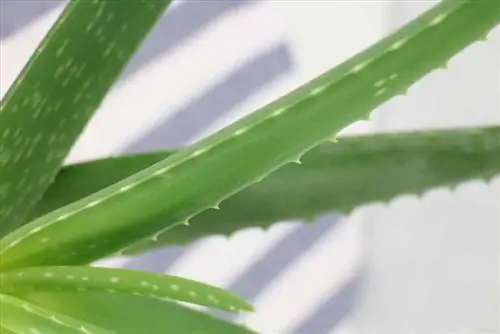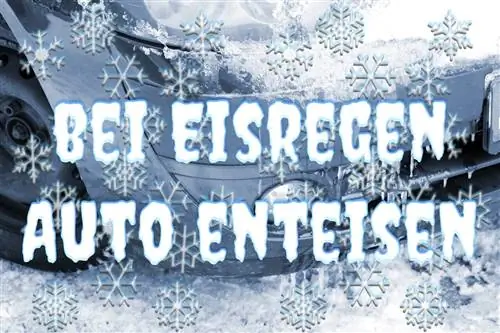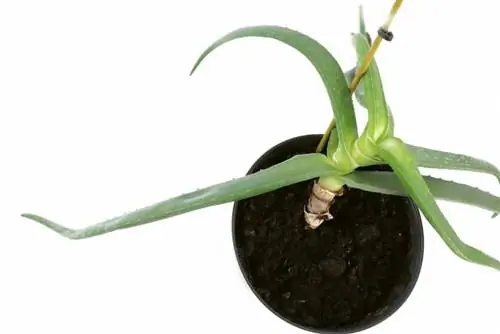- Author admin [email protected].
- Public 2023-12-17 03:39.
- Last modified 2025-01-24 12:45.
Aloe vera belongs to the lily family and is best known as a medicinal plant due to its positive properties. The succulent plant can be propagated using three different methods, although the chances of success can vary greatly. In addition, the amount of work involved and the time it takes to produce a well-rooted young plant differ. The children of the mother plant are perfect for quick and easy propagation.
Sowing
Raising with the help of seeds takes significantly longer than propagating with offshoots. However, if you want to grow a very specific and rare variety of aloe vera, this method is well suited. In principle, sowing is possible all year round, but there are certain seasons and climatic conditions in which propagation by seeds works better. Mild temperature values are optimal for the germination process; direct sunlight and heat should be avoided. To promote germination, the cultivation containers can be converted into small greenhouses. To do this, simply put a transparent film over the pot. However, the container must be ventilated daily, otherwise mold can form. As soon as the young plants grow strongly and the seedlings are about two fingers high, they are pricked out and placed individually in different pots.
- Seeds are available from specialist retailers and garden centers
- For extremely rare specimens, mail order is an option
- Your own harvest is also possible
- Sowing in spring is ideal because of better lighting conditions
- Aloe vera seeds are light germinators
- Need very bright and warm place to germinate
- Growing soil is ideal as a substrate
- Alternatively, a mixture of sand and earth is also possible
- Sprinkle seeds loosely over the substrate
- Keep sowing moderately moist and must not dry out
- Waterlogging must be prevented at all costs
- After a few weeks, seedlings appear
Propagation by Kindel
The easiest and most popular method for propagating aloe vera is the cuttings, which are also known as kindles. These sprouts sprout from the side of the trunk, but only when the mother plant is around three years old. For very young plants, this method of propagation is therefore not possible in the early years. Before cutting off the children, make sure that they have already formed their own roots. This makes reproduction much easier. In order to get an accurate picture of the growth progress of the offshoots, the entire mother plant is removed from the pot and then the appropriate child is removed. Aloe vera is a very undemanding plant and should not be watered too much. Only enough irrigation water should be given so that the substrate does not dry out completely.
- Carefully separate the child from the mother plant
- Offshoots should be at least 5 cm long
- Use only sharp and disinfected cutting tools
- It is essential to avoid injuring other parts of the plant
- Let interfaces air dry for a few days
- Transplant seedlings into their own container
- Insert into slightly moist succulent substrate
- Place in a warm and bright location
- However, avoid direct sunlight
Tip:
You should wait about a week after transplanting before watering for the first time. The young aloe vera is then watered and cared for as usual.
Propagate with cuttings

If the plant is not yet old enough or needs a long time to develop children, the aloe vera can also be propagated by cuttings from the well-developed leaves. In general, cuttings can be propagated at any time of the year, but success largely depends on the temperature. It should be noted that the leaves of aloe vera are very susceptible to signs of rot due to their extremely water-rich tissue. In order not to injure the mother plant unnecessarily, only sharp and clean knives may be used for cutting. Otherwise, bruising will occur, which will then begin to rot. The pot for the cutting should not be too large. The young aloe vera is only transferred to its final pot when the cultivation container is well rooted.
- Ideally carried out during the growing season in spring
- Cut off a leaf that is sufficiently large and growing on the outside
- Then divide the sheet into several equal-sized pieces
- Let the cut surfaces dry for a few days
- Then plant cuttings in sandy and slightly moist soil
- Put about 1-2 cm deep into the substrate and press lightly
- Leaf piece should stand upright
- Wait until roots form before watering first
- Then keep the substrate evenly moist, but not too wet
- A bright and warm location is ideal for the cuttings
- Protect from too much sun
Note:
Only the upper half of a leaf can be used as a cutting, but longer specimens must be attached to supporting rods so that they do not fall over.
Care for young plants
Aloe vera is a desert plant and can survive without water for some time. Drought is better tolerated than too many watering units, as the plant can accumulate liquid very well. However, the small young plants can only store a little water at the beginning and would suffer unnecessarily from waterlogging. In addition, aloe vera tends to form fungus and rot. In addition, the young cuttings initially cannot tolerate a lot of sunlight until they have fully developed their root system. As the cuttings begin to take root, they dry out and begin to shrink slightly. If the same size is maintained and the consistency becomes softer, the leaf pieces will rot. Choosing the right soil is extremely important for cultivation, as this can prevent signs of rot. Loamy and humus-rich soil is not suitable for succulents; they need a lean substrate.
- In the beginning, a dark location is ideal
- Only move to a bright and sunny place after the roots have formed
- Do not water young plants from above, only from the side
- In general, sparing watering is recommended
- Waterlogging can cause greater damage
- On the other hand, temporary dryness is well tolerated
- Sandy cactus soil is ideal for growing
- Rotting cuttings do not root and must be removed
- Root formation can be stimulated by rooting hormone
- Alternatively administer honey, willow water or cinnamon






